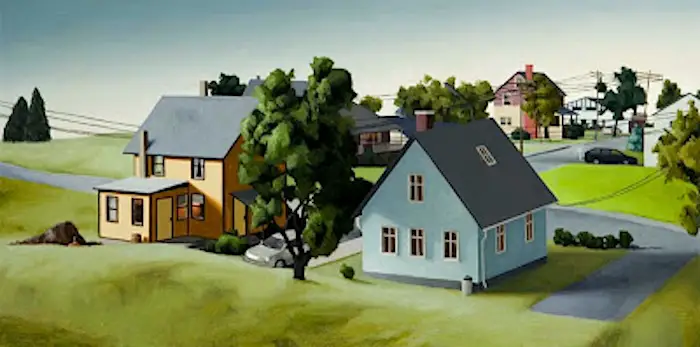
I inadvertently stumbled upon the paintings of Amy Bennett the other day and boy, am I glad I did. Now a new fan, I’d love to share with you this woman’s unique take on suburban landscapes.
The Paintings of Amy Bennett
Below are some images of Amy Bennett’s work. Done in oils, her works have a surreal and almost photographic quality, until one looks closer and sees both the darker narrative and the craft.
What looks like a set of dollhouse furniture is actually an oil painting telling a story of what at first glance looks like Mr. Rogers neighborhood, but upon closer inspection is a revealing glimpse of the human condition.
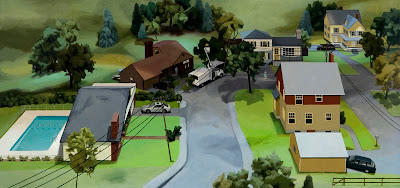
Below is both the artist’s statement as well as an interview which will give you far more insight into Amy’s work than my amateur observations.
While Amy also paints interiors, I am far more fond of her aerial paintings and her ‘dollhouse’ bisected homes which is what I’ve opted to share with you here.
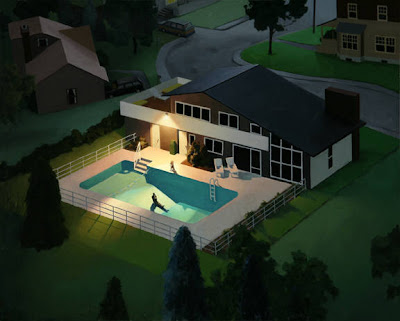
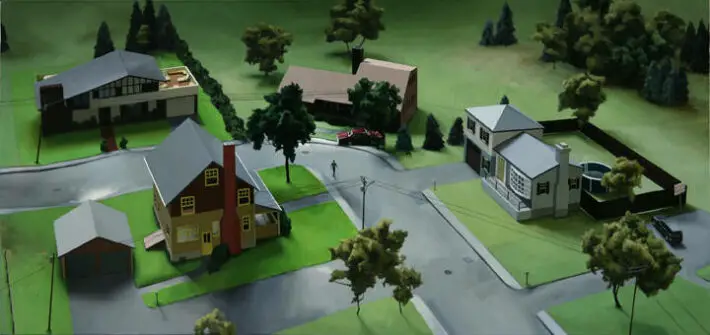
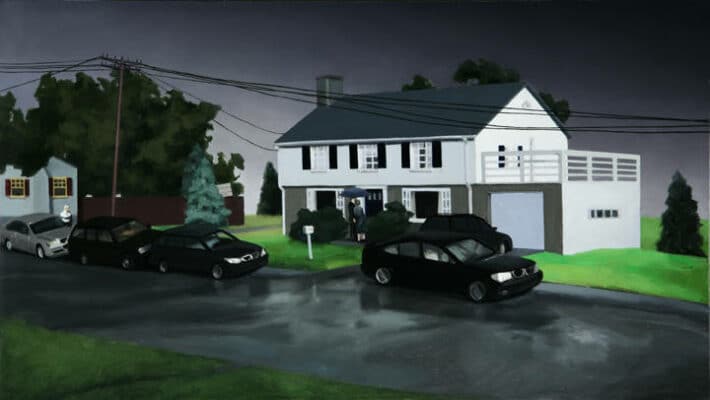


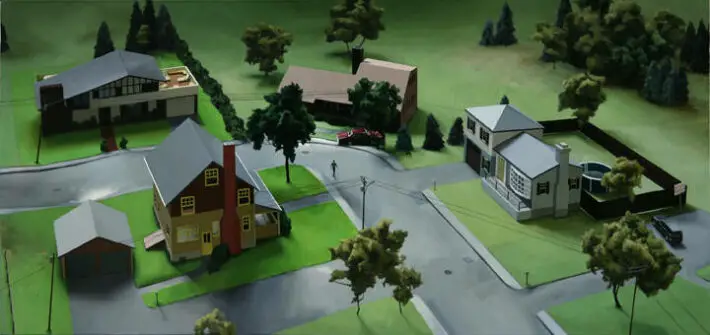
AMY BENNETT – Artists Statement:
In 2002 I began a series of aerial view paintings of apartments. Inspired by short stories, and game boards, I created floor plans to relate the dramas of residences in close proximity. As reference for each painting, I made model apartments from foam core, and furnished them with dollhouse miniatures. Over the past year, I have incorporated perspective and worked from a more normative point of view. My current series of paintings depict one family living in a modest home, isolated in a wooded landscape. I am working with common themes such as transition, coming of age, domestic responsibilities, and loss. I am interested in the awkwardness of a group of people trying to coexist and relate to one another, the fragility of relationships, and the uncertainty and anxiety of growing up. In the same way that we develop our concept of home, I have created these images, through memory, personal experience and imagination.

For this series, I designed, constructed and decorated a 1:12 scale wooden model with a removable roof and walls. Building the model prompts me to imagine the character of individual family members, as well as their relationships to each other in search of what it means to live in this house. My imagination fills the house with history, memories of significant events or moments, traditions, and daily rituals. I think: this is the room the sun floods every morning; this is the spot where the platter was thrown to the floor; this room used to be for sewing, but now there is a crib. While adjusting my model for each painting, I am considering the narrative role of order versus disarray, and the potential to make the condition of the house and arrangement of objects describe the occupants as well as consequences of incident. The model becomes a stage on which to develop the psychological implications of belonging to a particular family, with all of its dramas, struggles and familiar routines. Rather than illustrating these moments specifically, I attempt to invoke the feelings they elicit. I am exploring how distance between characters in compartmentalized spaces can create tension or a sense of tenderness, doubt, humor, or isolation.

One of my challenges is to invite the viewer to form his or her own connection and narrative. By removing a wall or ceiling, the viewer is privileged to explore a fictitious family’s private life, a home that is simultaneously cozy and unsettling. The house becomes a fishbowl, whereby the viewer may empathize with the occupants’ seemingly mundane existence.
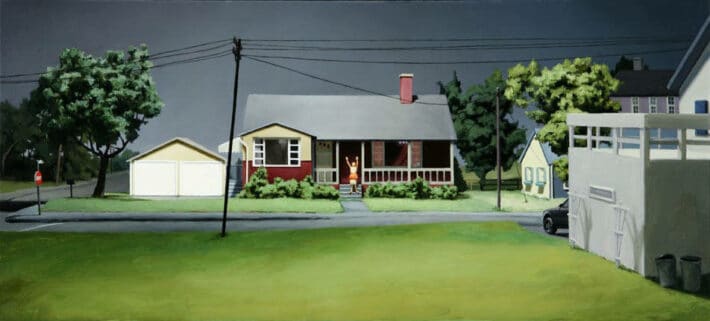
Below is an interview with Amy Bennett by Jenny Ziomek for NY Arts Magazine:
Amy Bennett is a Brooklyn-based artist who builds dollhouse-sized models of neighborhoods to stir up her imagination and to begin to create intricate and detailed stories of the families within it. Her paintings are striking, allowing the viewer to take a look into compelling and often dark homes, and reflect an extremely well-polished craft.
Jenny Ziomek: Describe the process of your work from conception to execution.
Amy Bennett: At the moment, my primary interest is in the cumulative storytelling effect of my paintings, in creating a group of narratives that may overlap and intersect to give a sense of history to a fictional place. So, I begin with determining the setting. My current series is set in a rural/suburban, New England influenced neighborhood. There are a couple of big farmhouses, but the rest of the houses are more varied and appear to have developed on the subdivided land of the farmhouses. I made a seven-foot square model to paint from, complete with a dozen or so houses, cars, trees, fences and even telephone wires. The streetlights and houses light up.
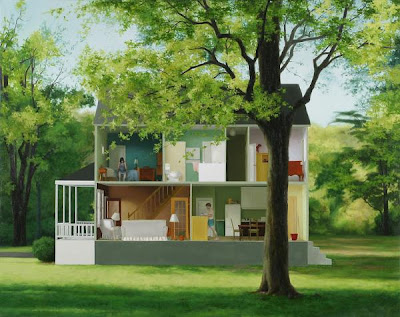
I started making the neighborhood by collecting some model railroading materials, assembling house kits and making a couple of garages, and lots of trees. I laid out the houses on a big sheet of paper on the floor. I traced the layout onto the paper and transferred it to the landscape that I had sculpted out of Styrofoam. The model required quite a bit of time to assemble, but it also gave me time to really think about the dynamics of the neighborhood. As I created each property, I considered who lived there and developed rough character sketches for the residents. I jotted down some of the stuff I came up with, but other residences were unforgettable because they were based on people I’ve known or houses I’ve been in. One house might be based on my grandparent’s last home, while another might be what I imagine their house was like when they were raising a family (so they’re neighbors with younger versions of themselves), while another house might be loosely based on a family I read about in either a newspaper or a book. Regardless of where the initial inspiration comes from, the houses and occupants all become fictionalized so that I’m free to invent.
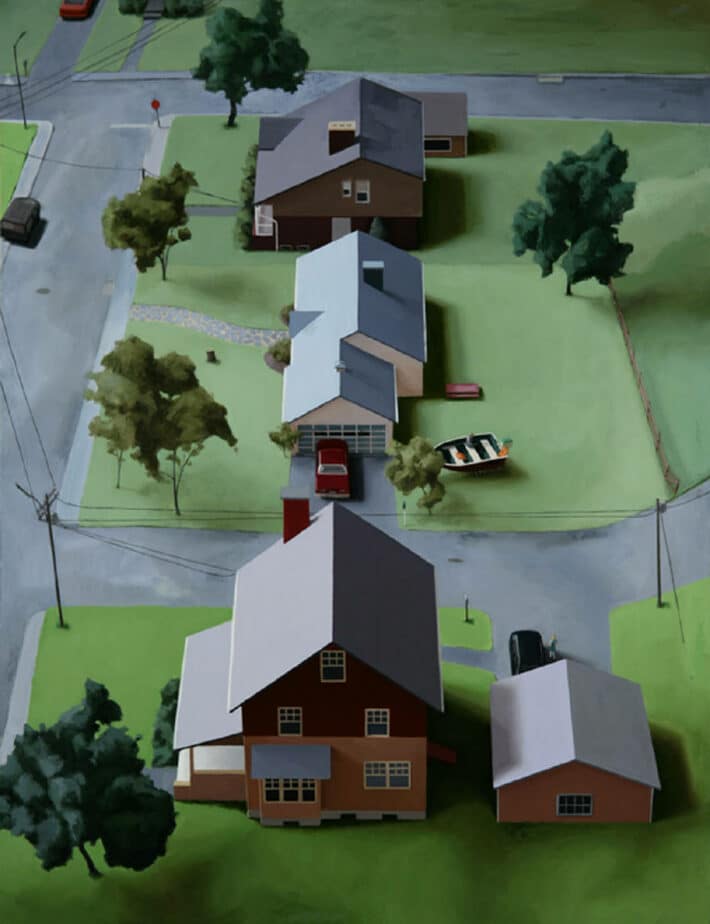
Each painting usually begins with a feeling or moment, and could belong to a sequence of images. I’ll then try to set up my model in a way that best gets my idea across. Playing around with the model is key to helping me develop narratives and images. Often, the model surprises me with something better than the scene I initially imagined. Also, lighting usually plays a key role in achieving the right mood. I usually document this play with my digital camera and then look through all the different things I tried, to see which arrangement and which lighting works best. Afterward, I set up the model accordingly. On average, I spend about a month working on a painting. Once it’s finished, I brush on layers of polymerized oil, sand it and a final coat creates a glass-like surface.
[More photos after the interview]
JZ: Your work is rich in narrative content, how do you construct this narrative?
AB: Reading, paying attention to the news, listening to music and my own experiences all trigger images, and then I think, what happens next? What prompted this? How does this effect another character? While this is happening, what else is going on—in the next room, across the street? Then I have this narrative that I can try to depict through my model. I just have to be flexible enough to let my model influence the narrative, too.
JZ: I find it interesting that you construct three-dimensional worlds and then present them in a two-dimensional painting. Have you ever presented the two side-by-side? Have you ever used photography, either as a tool during your process or as a final product?
AB: I displayed my model house alongside the series of paintings I made from it at my first solo show in Chicago at the Linda Warren Gallery. I hoped it would give some insight into my process, but I think it was misinterpreted as an installation, as an artwork in itself. I think of the model as a still life. I also consider photography as a means to an end. I use it as a kind of sketching tool in exploring different arrangements, compositions and vantage points. Painting from the model is very slow and meditative, and I think it suits the quiet content of my work much better than photographing it. Plus, the challenge of translating the three-dimensional to the two-dimensional is one that I thoroughly enjoy.
JZ: You say in your artist statement that some of your work is inspired by the “uncertainty and anxiety of growing up.” What was your personal experience of growing up, and how does this play into your work?
AB: I grew up in Maine. My parents were public school teachers and I am a classic middle child, with two sisters. My personal experience definitely does inspire many images, but I’m a very private person and always feel compelled to fictionalize, alter or distort my experiences before I’m comfortable enough to use them in my work. In fact, just by transferring my experience onto the model, it becomes changed, more interesting and, somehow, less embarrassing.
JZ: How do you come up with your titles, and how do they play into the paintings?
AB: Often, the title comes right at the beginning, along with the initial idea for the painting. But, sometimes it’s more difficult to pair an image with words. The paintings are specific scenes, but they are open to different interpretations, so I try to use titles that don’t direct the read too much.
JZ: Many of your titles are about waiting: for example, Waiting, Waiting For You to Come Home and Hours Passing Slowly. Why have you chosen this as a theme in your artwork?
AB: I frequently depict dramatic situations, but I also find many mundane scenarios to be interesting and true. A lot of time is spent waiting, whether it’s for a bus or the right person or for something else to happen. I think a lot of my paintings have that feeling, of being on the brink.
JZ: There is a definite theme of “home” in your paintings. Why is this a chosen topic of focus? Do you take any of your own experiences of home, either growing up or as an adult, and project them into your artwork?
AB: I have been setting my paintings in the home because it is where people let their guard down. Their public persona is shed in the privacy of their homes. Maybe it’s because I live in New York City, where our private space is so limited. I’m most interested in when the private becomes accidentally public and is exposed across lawns or overheard through walls.
JZ: Why have you chosen to render homes as plastic-looking and dollhouse-like?
AB: My narratives are fiction and are set in a fake world. The house/model becomes a stage on which to explore a psychological or emotional experience and the way people try to relate to one another. I’d like to emphasize realism and faithfulness to this kind of experience over the way things look. I am not documenting the reality of a specific place, but creating a place that the imagination can project itself onto. That’s just what a dollhouse is for.
JZ: The perspective in your paintings (which is generally a bird’s eye view, if not outside of the home at a great distance) makes us, as viewers, feel separate from and almost voyeuristic towards the scenes that we are looking onto. Why have you chosen such a perspective?
AB: A bird’s eye or distant view is like an omniscient narrator where the viewer/reader is privileged to more information than a more limited perspective would provide. By zooming out a bit, so that more of a scene is revealed, you get the sense that what you’re seeing is just a small part of larger puzzle. By seeing the proximity of one home to another with an awareness of the various dramas and events that each has experienced, the viewer is invited to discover narrative connections and to empathize with the characters.
JZ: Where and when can we see your upcoming shows/events?
AB: I just had a show in LA at Richard Heller Gallery in January 2007. I’m currently working on a show for this September at Galleri Magnus Karlsson in Stockholm.
Pieces from BURIED, her solo show at Galleri Magnus Karlsson in Stockholm, 2007:



www.amybennett.com
You can also find Amy’s work at the following galleries:
•Miles McEnery